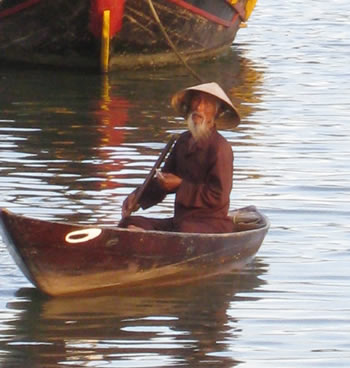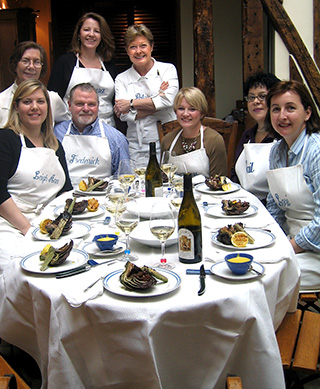Many culturally hungry Americans dream about moving to France. “We’ve Always Had Paris ... and Provence” is the story of two who did so and have lived happily ever after. Patricia Wells, known best for her seminal “Food Lover’s Guide to Paris,” and Walter Wells, a high-ranking editor of The International Herald Tribune from 1980 to 2005, have written a he-said, she-said memoir, volleying back and forth to tell how a girl from Wisconsin and a boy from South Carolina met while working at The New York Times and went to France in 1980 on what they assumed would be temporary journalistic assignments. They found their lives’ calling as expatriates, transcending prejudice to be accepted and even revered by the foreign culture they embraced. Walter was awarded the French Legion of Honor. Patricia recounts with no small measure of self-amazement the time she showed the Frenchman Joël Robuchon, “the greatest chef in the world,” how to make her special bouillabaisse.
The couple describe France’s allure with converts’ enthusiasm. Of her early research for the guide book, Patricia writes: “Everything was new, bright, exciting. There were so many first-time experiences, so many thrilling new tastes. ... Many a night, as Walter walked in the door from work I would shout with joy, ‘I just had one of the best days of my life!’ Walter would respond, ‘You say that three times a week.’” Regarding their decision to stay abroad, he writes: “Why Paris? What was it about the city that pulled us there and kept us? Well, how high is the sky?”
Patricia’s accounts of Provence are full of storybook moments. Of their house, Chanteduc, she rhapsodizes: “We did plant a butterfly bush, a buddleia, that we cut back in winter. From spring until late autumn its brilliant purple flowers attract white and yellow butterflies that dance around over the terrace. One day the Three Tenors were singing loud and clear from the speakers in the corners of my kitchen, and I would swear that the butterflies were dancing to the music. It made me cry with happiness.” Of Provence itself, “It symbolized all the essential elements of the happiness we sought in life: friends, family, food and feasts.” Walter’s description of Chanteduc as it was when they bought it is less starry-eyed: “The bathrooms were inadequate, the windows didn’t shut out the wind, and those tangles of wire in the basement meant that the electricity needed attention, too.” Although he notes that “even a fantasy life has its share of uphill struggle,” Walter is smitten in his own way, rhapsodizing about all the merchants of which they become clients fidèles, creating for him and his wife a sense of community.
A memoir is intrinsically self-centered, at best offering a fresh vision of the world through other eyes, at worst reading like an overlong Christmas letter. Patricia Wells’s recipes, which follow every chapter, are indeed delicious and unusual, some so evocative that you can practically smell the lavender fields outside the kitchen window and feel the chill of the mistral. Appearances of Robuchon, Julia Child and a Provençal truffle hunter are frothy peaks in the story. But when the Wellses focus on themselves the cream curdles. The book is overloaded with pictures of them separately and together, beaming out at us with politicians’ pasted-on smiles, perfectly outfitted for a night on the town or a morning in the garden, always looking just right and manically happy. It is not just the canned pictures that make it difficult to relate to our omnipresent bibliohosts the way it is so easy to do in such disarming memoirs as Peter Mayle’s “Year in Provence” and Adam Gopnik’s “From Paris to the Moon.” They write like ad men trying to sell readers on the excellence of their self-proclaimed fantasy lives, from the distinctive wines they make to Patricia’s triumphs as a long-distance runner. Without irony, Walter quotes the cookbook editor Maria Guarnaschelli observing their shopping habits in France: “You originated the Dean & DeLuca lifestyle.” He then sincerely boasts that their lifestyle is even better than that, because the excellent butcher delivers their leg of lamb to Patricia’s car, “parked far away.” What might have been a delicious invitation to a banquet winds up reading like a brochure for an expensive gated community
Do we need to know that Patricia’s personal maintenance routine consists of “weekly visits to the hairdresser for upkeep and a manicure, twice a week to the massage therapist, a weekly facial, a monthly pedicure”? She reveals, “I even multitask when I have a facial, having facial hair removed and putting my eyelashes up on rollers so they have an even curl.” The payoff for her beauty routine comes “when Walter and I passed a woman who clearly did not subscribe to the maintenance theory. Her hair was a mess, and dirty as well. She walked with difficulty, overburdened by excess weight. Her clothes were rumpled and too tight. She wore no makeup and the deep wrinkles on her face suggested she was a lifelong smoker. Walter turned to me and said quietly, ‘Thank you for taking care of yourself.’” L’addition, s’il vous plaît!
Jane and Michael Stern are the authors of “Roadfood.”








